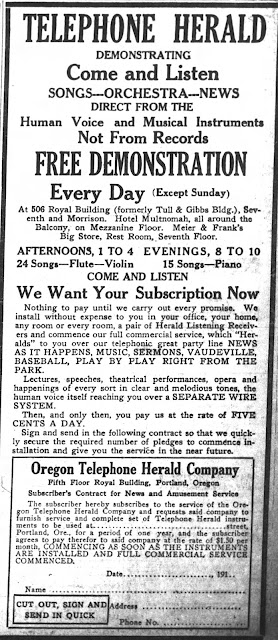© Mark Ollig
In May of 1898, the New York City Electrical Show took place at Madison Square Garden.
The New York Times newspaper reported 300,000 people attended the month-long event.
At the Electrical Show, The New York Telephone Company installed a switchboard with telephone wiring connected to five New York City musical theater locations where stage microphones were installed.
The switchboard would allow sixty listeners in Madison Square Garden to hear musicals using the theatrophone (the theater phone).
The theatrophone was invented by Clément Ader, who demonstrated it during the 1881 World Expo in Paris, France, where it was well received.
On May 24, 1898, the Brooklyn Daily Times newspaper reported people in Madison Square Garden were astonished listening to the stereophonic-sounding musical performances telephonically transmitted from the theaters.
The newspaper added theatrophone listeners were surprised to hear a live musical performance from Milwaukee, WI (through the long-distance telephone network) via the New York Telephone Company switchboard.
During this time, entertainment and news sent over telephone wires had become popular in France with the Theatrophone Company, in England with the Electrophone, and in Budapest, Hungary, with the Telefon Hirmonde, meaning “Telephone Herald.”
Originally called the Telephone Newspaper Company of America, in 1909, it was incorporated in New York as the United States Telephone Herald Company.
Its business would be to bring telephonic audio entertainment, special events, and news services over telephone lines into homes throughout the U.S. The success of Telefon Hirmonde strongly influenced the company’s creation.
The United States Telephone Herald Company planned to establish a network of 14 associate companies, each providing telephonic news and entertainment to subscribers for a monthly fee.
The associate companies would obtain the wired network infrastructure needed for telephonic audio services by leasing telephone lines and equipment from the local telephone companies.
In 1910, the New Jersey Telephone Herald Company, one of the associate companies, attempted to lease local telephone lines from the New York Telephone Company.
The New York Telephone Company refused to lease them; however, they ended up cooperating after being persuaded by a higher power.
On Sept. 8, 1911, the New Jersey Passaic Daily News newspaper reported the New York Telephone Company was directed by the Department of Public Utilities of New Jersey to furnish leased telephone wires to the New Jersey Telephone Herald Company.
A month later, the New Jersey Telephone Herald Company officially began providing telephonic audio services over leased telephone lines. Its telephonic services included a daily music schedule, special events, and up-to-date news from telegraph wire reports and newspapers.
On June 14, 1912, the Oregon Telephone Herald Company, another of the 14 associate companies, wrote in the Oregon Daily Journal that it was “commencing their full commercial service, which ‘Heralds’ to you over our telephonic great party lines news as it happens.”
They added, “baseball play-by-play right from the park, theatrical performances, opera, and happenings of every sort in clear and melodious tones, the human voice itself reaching you over a separate wire system.” Their newspaper article said the billing rate amounted to five cents per day.
Only two associate companies, the New Jersey Telephone Herald Company and the Portland Oregon Telephone Herald Company, would provide telephonically delivered services to paying subscribers.
However, both companies could not raise the revenues needed to remain solvent, and in 1913, their telephonic operations ended.
On June 14, 1914, the Minneapolis Sunday Tribune newspaper reported: “conversation and music floating through the atmosphere above the housetops and buildings of Minneapolis and St. Paul, and audible only through a wireless receiving apparatus [radio receiver].”
Minneapolis residents James Coles, an amateur radio operator, and William Reynolds built the radio transmitting station broadcasting music from a phonograph; at times, Coles spoke over the radio transmitter.
Radio broadcasts were seen as the future for obtaining news and entertainment, as amateur radio stations had begun over-the-air transmissions listenable at no cost to anyone having a radio receiver.
In February 1915, the United States Telephone Herald Company lost its corporate charter due to nonpayment of taxes and was out of business.
On Nov. 7, 1916, U.S. presidential election returns were transmitted wirelessly with the voice of Walter Schare from Lee De Forest’s amateur radio station 2XG in New York City.
Schare read the election returns over the air via telephone reports from the telegraph office of the Buffalo News.
Music was played by 2XG to radio listeners whenever Schare waited for updated election returns.
“Seven thousand wireless telephone operators within a radius of 200 miles of New York City received election returns,” was reported in newspapers.
On Oct. 27, 1920, the first U.S. commercial radio broadcasting license was obtained by
KDKA (radio call sign 8ZZ) in East Pittsburg, PA.
By 1922, radio was enormously popular with the public; even the 1922 Chevrolet Touring Sedan automobile featured a factory-installed Westinghouse radio.
Radio stations would rule the airwaves for the foreseeable future – or so it seemed.
That is until May 1928, when pioneering television station W2XCW (WGY/WRGB) began a three-day televised schedule from Schenectady, NY.
Looking back to 1881, Clément Ader would probably have invented the “theatrophone radio television” if the technology had been available.
 |
| New York Newspaper ad from 1898 |
